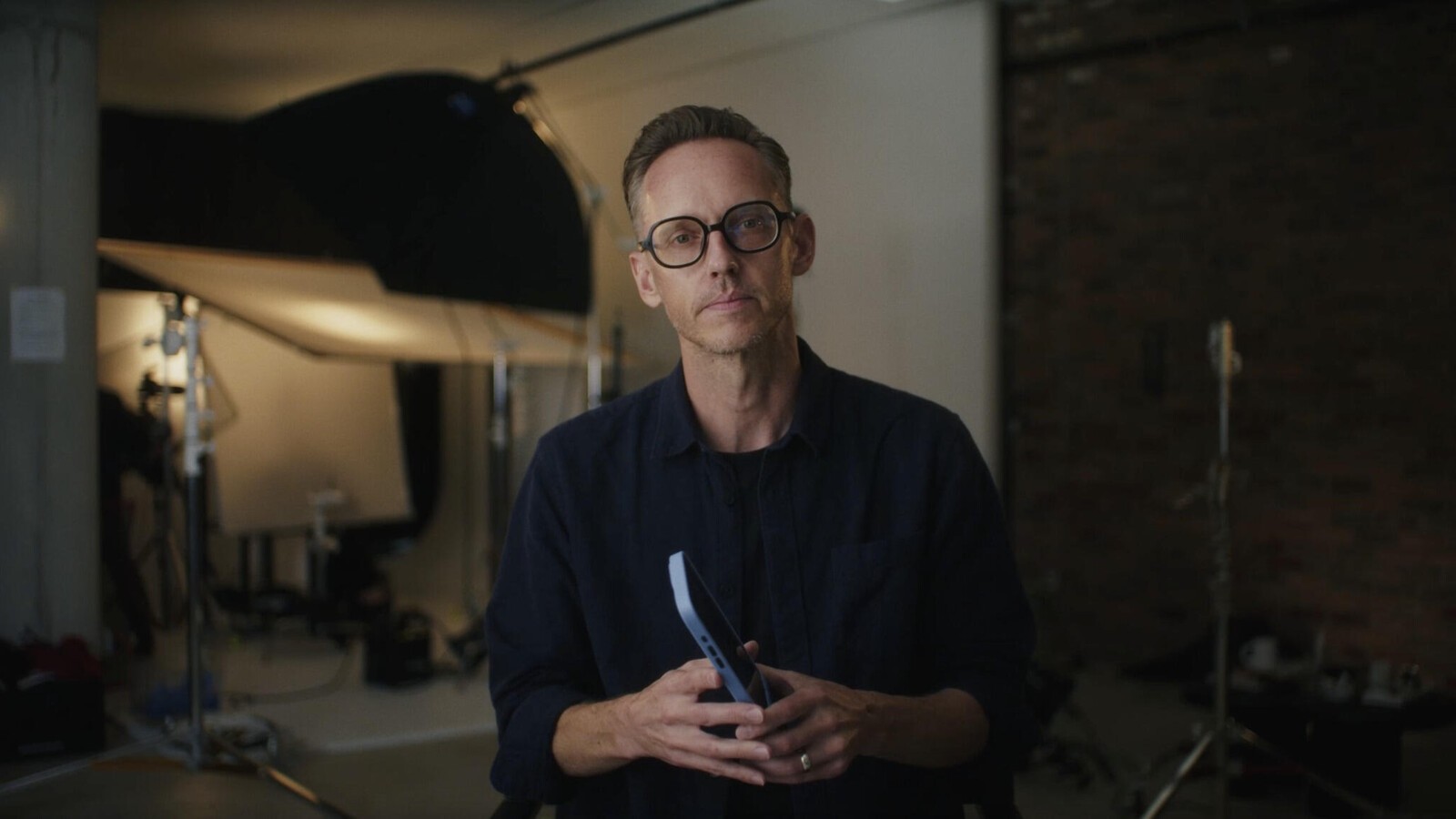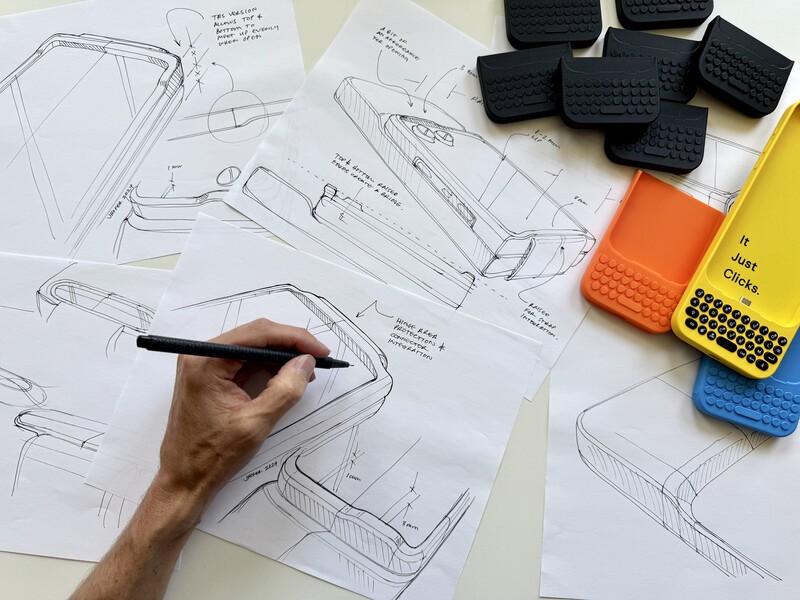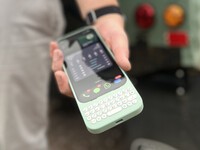
Every detail of the Clicks keyboard was designed with intention—and few people understand that better than Joseph Hofer. As a former lead designer behind BlackBerry's most iconic keyboards, Joseph brings decades of experience in ergonomics, tactile design, and product craftsmanship. In this conversation, he shares what makes a keyboard truly great, how Clicks evolved from BlackBerry DNA, and why hand tools (yes, including smartphones) still matter more than ever.
1. You've been called one of the most influential figures in keyboard design. What drew you to this incredibly niche but critical craft in the first place?
Considering the hours invested over my career obsessing about the layout, tactile feedback, and resulting typing speeds and accuracy, I can see how that experience has helped me earn a voice on the topic.
Prior to entering the design space, I was a woodworking enthusiast. Surrounded by traditional hand tools by the likes of Stanley, Snap-On and Starrett, I observed a level of quality and ergonomics that I didn't see present in many other product categories at the time. The safe use of hand tools is influenced as much by how intuitive, ergonomic, and trustworthy they are as it was by user skill. Using these tools for many years developed a keen sense of awareness of what makes a product earn the right of being 'high-quality'.
During my time at BlackBerry, I grew to consider smartphones as hand tools—tools for communication. They had to fit the hand comfortably, all buttons within easy reach, and have a high performing keyboard. Likely this is what still keeps me passionate about keyboard design.
As long as humans have hands, we'll have hand tools.
2. You were instrumental in the evolution of BlackBerry's iconic keyboards. What lessons or breakthroughs from that era did you carry forward into the design of Clicks?
Early in my career at BlackBerry I apprenticed under Jason Griffin, who was even more obsessed about the typing experience than I was. We spent a lot of time brainstorming, prototyping, and testing numerous ergonomic designs, with the aim of meeting the high standards of founder and co-CEO Mike Lazaridis.
As phone sizes reduced in width over time, we found innovative ways to indicate key locations to a user's thumbs. Initially we used the edges of oval keys that were spaced apart, but then moved to what we referred to as ErgoSurf, which was a wave/crest within a square key. This gave the tactile impression of an edge of an oval key, but allowed us to create keys that were touching, resulting in a larger surface area for graphics. This wave/crest found its way into the full lineup of BlackBerry smartphones due to its ergonomic superiority.
When it came to rethinking Clicks ergonomics, we were starting with an already amazing keyboard design the team had initially shaped for the first generation of products. However, I felt that as the keys were enlarged and pushed closer together to create a larger surface area for graphics, we lost some of the tactile separation a user needed between each key. By 'curling' up the innermost corner of each key slightly, we were able to exaggerate the feeling of separated keys, not that much unlike ErgoSurf on BlackBerry. But reimagined in a new execution. This created a 'braille-like' feeling whereas gliding a thumb across the keypad, each key is now felt, more accurately.
3. The "click" of a keyboard is deeply personal to users — how do you engineer that perfect tactile feel? What goes into getting that just right?
There are many factors that contribute to what makes a click. First there's the experience intent, which the team reverse-engineered into the technical stackup.
The experience intent consists of pressure needed to click, the depth the key moves, where in the depth of movement the click happens, how stable the key is (does it rock or stay planar), how fast does the key snap back into place ready for the next press (for double presses), the amount of physical feedback felt from the click, and lastly the sound and volume of the click.
Since a keypad is made of many layers of different materials from plastic, rubber and metal, getting this right takes trial and error, always made easier with an experienced manufacturing partner.

4. From a design and engineering standpoint, what makes the Clicks keyboard different from other mobile keyboards — physical or digital?
Though we care about the branded iconic circular layout of the Clicks keyboard, the utility and performance has to be best in class. We'll never sacrifice that to look cool. I see other keyboards designed to blend into the product, or feel super modern–but they are simply not great to type on. Especially at the typing speed and amount of usage we expect Clicks users to exhibit.
5. You now run your own business. How does using Clicks in your day-to-day workflow help you stay productive and focused?
As a product advisor to multiple partners and clients, I'm in Slack all the time. I can't imagine going back to a virtual keyboard and losing half the conversation visible when I'm typing a response. As a visual thinker, a larger monitor or screen always helps me be more productive.
Secondarily I love the shortcuts, like disarming the studio alarm, mapping back to the studio from anywhere, switching to Airplane mode for meetings, and letting my wife know I'm on the way home.
6. What are some small, often overlooked details in Clicks that you're most proud of as a designer?
I would say the consistency we've been able to maintain across the portfolio in a high growth stage of a startup like Clicks. Details are often lost in translation, and I'm proud of what we've been able to achieve across timezones, languages, cultures as a product development team. We've worked out formulas and principles that help sort out ergonomic specifications to cover any size of phone we end up designing for.
7. How has your design philosophy evolved over the years, and how does Clicks reflect where you are today creatively and professionally?
When some of my earliest products are referred to as iconic or 'heritage', it makes me take a step back and reflect on how quickly time passes when we focus on doing what we love.
Advising Clicks has been a complete joy, as it brings back so many memories, learnings and ideas that I had placed on a shelf whilst further establishing my design philosophy that's changed little since I started out.
That is to create products that fulfill an unspoken need, earn trust, and outlast the trends.
Learn More About the Clicks Keyboard
Learn more about the Clicks Keyboard for the iPhone, Google Pixel and Moto RAZR at Clicks.tech! Or, watch these great videos:
Clicks Keyboard for iPhone - Ultimate Guide
Clicks for Android Unveil
Follow Clicks on Instagram / Twitter / Threads / Facebook / TikTok / Reddit / Discord
Read more

Q&A with Clicks CEO, Adrian Li Mow Ching
A Father’s Day Q&A with Clicks CEO, Adrian Li Mow Ching — CEO, Entrepreneur, and Full-Time Dad

Clicks Into Summer and Win a new Smartphone with Clicks Keyboard!
Click Into Summer and Win Your Choice of a new iPhone 16, Google Pixel 9 or Motorola RAZR+ and Clicks Keyboard!

Meet Karl Parry and his one-of-a-kind Heritage Edition Clicks Keyboard
Meet Karl Parry, the Clicks Customer who helped the Clicks Team bring "Clicks Mode" to life.